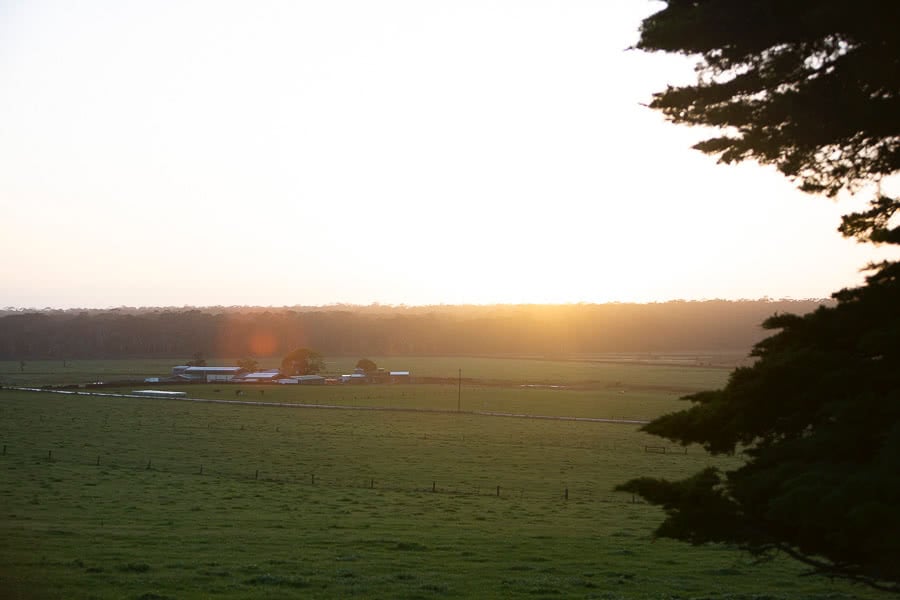Meet Tanya Ghosn (nee Castle).
Victorian Kangaroo is on the menu
We follow simple process;
- Pasture raised
- Pasture fed
- As nature intended
The traditional values of reducing waste have never been more relevant than now. When the Castle Estate (butcher and abattoir) prepares an animal as a source of food, they operate under the firm belief system that the whole animal must be utilised to minimise waste and avert frivolous farming.
Check out our range of meat for your summer bbq here, we have weekly offers and provide home delivery direct from our farm.
If you need some more information please get in touch,
- Address: 191 Purrumbete Estate Rd, Koallah, VIC 3260
- Telephone: +61 3 5594 5222
- Fax: +61 3 8677 5469
- Email: [email protected]
The Castle Family
If you're like many Australians, you probably have some favourite foods that you enjoy eating year-round. However, eating the same foods throughout the year is not that good for you. What's more, you shouldn't expect to be able to get these foods all year. Are you someone who cares deeply about your health and the environment? Here are five of the main health and environmental advantages for eating seasonal foods, along with what we have to offer.
1. MEETS YOUR NUTRITIONAL REQUIREMENTS
Most likely, the primary health benefit of seasonal eating is that it supports the natural nutritional needs of your body. For example, now during summer, there are several summer foods that give us additional beta-carotenoids that are helpful in protecting against sun damage.
During winter, nature provides us with essential high Vitamin C nutrients that are so crucial in preventing cold and flu infections. Some of the top winter foods that are ideal for hot meals, besides provide comfort, include those, such as soups, healthy stews, casseroles and other warm dishes.

2. PROVIDES HIGHER NUTRITION
Seasonal produce is usually much fresher since it's consumed closer to where it was harvested. It also has a higher nutritional value, including Vitamin C, carotene, folate and other antioxidants. Consider how it won't deteriorate as quickly when it's stored for a long time period. Additionally, seasonal produce looks more vibrant and brighter.
Just think about how produce that's been stored for an extended time because it has transported tends to be limp and dry. It's important to realise that often larger grocers and markets purchase out-of-season produce that has been wax-preserved for extending shelf life.

3. PROTECTS YOUR BODY FROM CONTAMINATION
Unfortunately, too many countries are lax about chemicals sprayed on fruits and veggies that other areas have banned because of damaging effects. There are some areas with extremely high heavy metal as well as other toxic pollutants that are the result of being near industrial sites. Consider that in the news, not that only ago, here in Australia, there was a large hepatitis A contamination due to frozen berries coming from China. Because of poor overseas hygiene practices, many Australians were infected.

4. IS MORE APPETISING
Besides being fresher and healthier, seasonal foods taste a lot better and are sweeter. When produce is allowed to ripen naturally on the vine and is harvested at the proper time, it has a better taste and is more nutritional. When crops are transported, the produce has be harvested earlier than it should be as well as refrigerated to prevent it from spoiling while being transported.
When food is chilled, there's less flavour. By the time the produce arrives at its destination, it usually needs to be heated and placed in a hot house so that it can ripen artificially before going on shelves. This is why some fruits and veggies, such as apples and tomatoes, lack flavor. Even worse, sometimes, foods arrive almost rotten inside.
5. HELPS THE ENVIRONMENT
Besides promoting good health, seasonal eating creates less of a demand for producing out-of-season produce. As a result, there's more support for local fruits and vegetables, which leads to supporting local farms in your area. What's more, this reduces transportation, in addition to needing less refrigeration and hot houses, along with less produce irradiation.

THE BOTTOM LINE
- If you want to eat healthier and tastier foods, besides help the environment, choose seasonal foods. Order fortnightly - order seasonally.
- Some of the best summer meats include foods, such as beef, lamb and chicken. Ideal veggies that can be paired with these meats may include those, such as eggplant, corn, carrots, coriander, potatoes, lettuces, tomatoes spring onions, snow peas, zucchinis and beetroots.
- You can get depend on Castle Estate for the highest quality.
- We are not a Feedlot and only follow nature.
- We slaughter to order, Our meats come from grass-fed not grain-fed animals.
- To set up an account for your weekly orders, contact us.
- Address: 191 Purrumbete Estate Rd, Koallah, VIC 3260
- Telephone: +61 3 5594 5222
- Fax: +61 3 8677 5469
- Email: [email protected]
Feedlots play a huge but controversial role in raising beef cattle in Australia. The sector has grown, with approximately 40% of Australia's total beef supply sourced from feedlot animals. The feedlot sector has grown over the past 20 years to become a $2.7 billion industry. Recent information shows that 80% of all beef sold in the majority of Australian supermarkets is cattle feedlot sourced. Currently, there are around 600 feedlots throughout Australia, with the majority located in farming states and territories like New South Wales and Southern Queensland.
While feedlots help "drought-proof" Australia's beef industry by ensuring a constant beef supply to domestic and international markets, there are growing concerns about animal welfare and its effect on the environment. Before we explore these concerns and more, let's first define what feedlots are.

What are Cattle Feedlots?
Feedlots are yarded areas where cattle, after being raised on pasture, are held in close confinement and fed in groups until they reach certain weights prior to being slaughtered. Here, cattle live in tightly confined spaces with hundreds if not thousands of other cows; they are fed excessive amounts of feeds and receive copious amounts of drugs (i.e., antibiotics) to keep them uncontaminated and alive.
Although the industry is regulated and claims it follows environmental safety standards, in most cases, animals' welfare in feedlots is mostly determined by the facility's management. This leaves a huge gap for lapses in animal welfare and environmental concerns.
- Unhealthy Environments
Feedlots are fenced-in outdoor areas where cows are crammed together to prevent them from exercising and obstructing the fattening process. The spaces are barren, lacking grass for cows to graze and trees for shade. Cattle have to stand in these small crowded areas in the ruminants of their own urine and faeces.
Feedlots can get very muddy when it rains, causing cows to become wet, cold, and dirty. When it gets hot during droughts or summer, the lots become dusty and dry. With the lack of shade coupled with excessive weight brought on by being fed increasingly heavy diets, cows often experience heat stress problems that can sometimes prove fatal. Currently, there's no legal requirement for farmers to provide shelter to cows in feedlots.
- Pollution
Feedlots produce huge amounts of animal waste and other pollutants that can be harmful to the environment. Feedlot waste is likely to contain cleaning agents, silage leachate, chemicals used in livestock care, antibiotic-resistant bacteria, ammonia, heavy metals, and milkhouse waste.
This waste is often stored for a while in waste storage pits or structures before disposal on farm fields. This is where feedlot waste enters surface water, contaminating it, causing water pollution. Runoff of feedlot waste into water streams can be detrimental to fish and other aquatic life and can cause "dead zones" in coastal areas. Feedlots also cause air pollution due to ammonia, particulate matter, odour, greenhouse gases, and volatile organic compounds emissions.
- Artificial Diets
In natural environments, cows spend up to 12 hours grazing on grass; in a feedlot, they are fed a high-energy, high-fat diet of barley and wheat. However, the cow's digestive system isn't designed to continually consume corn or grain products, causing them to get sick often. As a result, they're given a constant dose of antibiotics. Animals in feedlots are fed in this manner in order to reach the market weight requirements.
- E. Coli Contamination
E.coli bacteria are often found in animal waste, and since feedlots confine cows to small spaces filled with feacal matter, E. coli contamination is inevitable. Cows that are fed a high corn diet also have increased E. coli amounts in their digestive tracts. E- Coli contamination can cause illness in animals as well as humans.
- Injury, Illness, and Early Death
Animals can suffer a wide range of injuries and illnesses in feedlots caused by the feedlot environment, dehydration, stress, unnatural diets, and transportation. The most common diseases include acidosis, botulism, bovine respiratory disease, pink eye (blight), footrot, tick fever, and feedlot bloating.
Although most of these diseases are treatable, due to a large number of cows in the feedlot, sick cows might not be identified early, resulting in death.

Conclusion
Confining animals in small areas where they can't naturally graze as they should go against everything we stand for at Castle Estate. We believe animals must be free to roam and graze as nature intended- grass only, not grain-fed in lots. Grass-fed beef is also better than grain-fed beef as it has significantly lower levels of saturated fat and is higher in nutrients and antioxidants. But with 80% of all beef sold in the majority of domestic supermarkets sourced from the cattle feedlot sector, your best bet is to avoid buying meat from the supermarket. Order your weekly meat from Castle Estate.com.au.
Sources
- https://www.dpi.nsw.gov.au/animals-and-livestock/beef-cattle/husbandry/hormonal-growth-promotants/q-and-a
- https://www.business.qld.gov.au/industries/farms-fishing-forestry/agriculture/livestock/cattle/hormonal-growth-promotants
- https://www.al.org.au/feedlots/
- https://futurebeef.com.au/knowledge-centre/feedlots/#:~:text=Approximately%2040%25%20of%20Australia's%20total,to%20over%20100%20international%20markets.
- https://kb.rspca.org.au/knowledge-base/what-are-the-animal-welfare-issues-of-feedlots/
Get some meat done better this Australia Day holiday
Celebrate Summer with these great Aussie BBQ boxes.
We have options for intimate gathering or feed the neighbourhood!
Delivered from farm direct to your door from only $90, grass fed, hormone free naturally.

We also have our weekly seasonal boxes and some deals for you click here to see them or simply just order your favourites.
Get some meat done better this australia day..
Go on put some meat on the Barby!
Don't forget your old account will work on the new website and if you refer a friend they get $20 voucher and so do you!
Order Cut Off – for Australia day meat delivery Tuesday 19th Jan 9:00am
Delivery Friday Jan 22nd
Delivery Saturday Jan 23rd
CLICK HERE TO ORDER
Order Cut Off – Monday 25th Jan 9:00am
Delivery Friday Jan 29th
Delivery Saturday Jan 30th
CLICK HERE TO ORDER
We would love to hear about your favourite summer recipe - please send one into us! Once again from our family to yours we would like to thank you for your business, we are always grateful for your support, thank you for choosing us.







